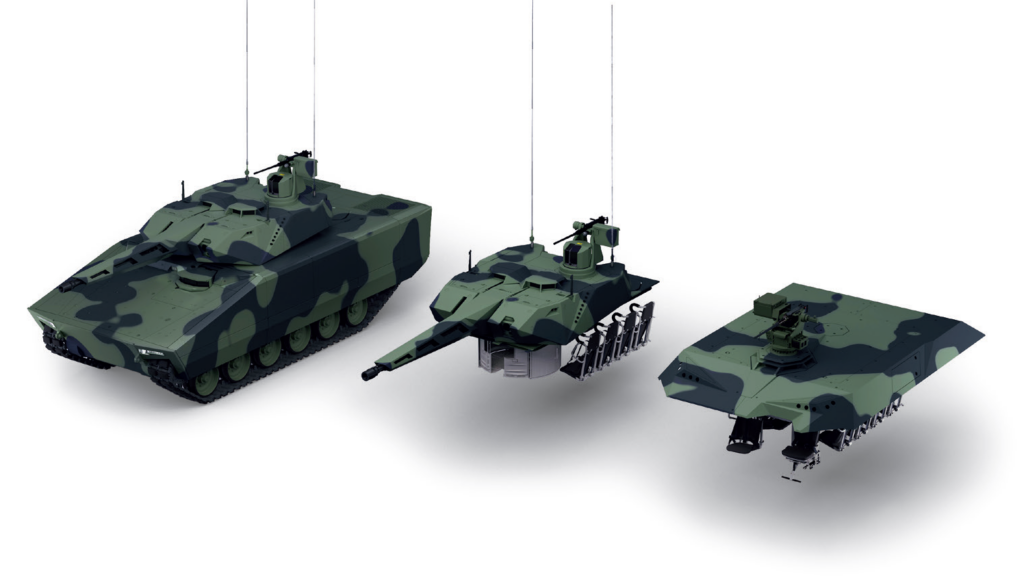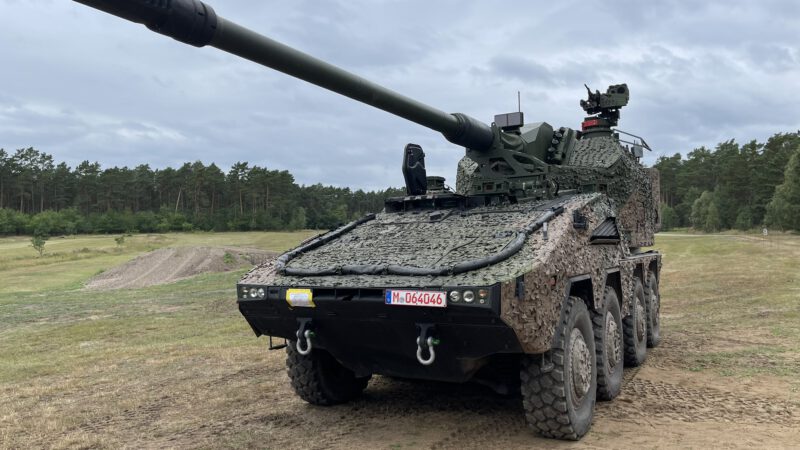Rheinmetall reveals renderings of OMFV Lynx

American Rheinmetall Vehicles, the Michigan-based subsidiary of German defence company Rheinmetall, has revealed first 3D renderings of its Lynx KF41 variant offered to the US Army’s Optionally Manned Fighting Vehicle (OMFV) program. Under this program the US Army wants to procure a replacement for its outdated M2 Bradley infantry fighting vehicle (IFV). Aside of American Rheinmetall Vehicles, BAE Systems, General Dynamics Land Systems, Oshkosh Defense and Point Blank Enterprises have been contracted to develop digital designs of their offers. In a later step of the program, actual prototypes will be manufactured.

The Lynx KF41 is a privately funded tracked armored fighting vehicle (AFV) developed by Rheinmetall. It follows the German company’s strategy to convert the company from a component supplier to a “system house” capable of independently designing its own vehicles while utilizing as many Rheinmetall-made parts as possible. Among other things, the ballistic protection, the coaxial armament, the control panels & displays, the generic vehicle architecture (GVA), the main gun, the anti-tank guided missile (ATGM) launchers, the optics and optronics, parts of the running gear, the smoke grenade launchers and the situational awareness systems fitted to the original Lynx KF41 IFV demonstrator, which was first presented at the Eurosatory 2018, were all made by Rheinmetall or companies under partial ownership of the Rheinmetall Group.
For the American OMFV program, Rheinmetall has teamed with a number of local companies, i.e. Allison Transmission, L3Harris Technologies, Raytheon Technologies, and Textron Systems. While the former three companies are to provide sub-systems for the Americanized version of the Lynx KF41, Textron Systems will be responsible for the production of the Lynx KF41’s hull, if the design is selected by the US military; the turrets are to be manufactured by American Rheinmetall Vehicles in Louisiana. This teaming is understood to provide multiple benefits: integrating components already qualified or adopted by the US Army makes the Lynx more attractive to the customer, while increasing the amount of US workshare makes it less likely that Rheinmetall’s offer is rejected for being a foreign system; last but not least Rheinmetall lacks production facilities for AFVs in the United States.

The Lynx KF41 IFV was not designed to meet the requirements of a specific procurement program but rather is based on Rheinmetall’s predictions of customer demands in the near to mid future. Thus adaptability has been a major aspect in the Lynx’s design, so that it can be fine-tuned to meet the final demands of each individual customer. Its reconfigurable torsion bar suspension made by the Australian company SupaShock – of which Rheinmetall acquired 49% in 2017 – allows the vehicle to cover a wide weight range from 34 to 50 metric tons, enabling the integration of different armor kits or mission packages. Like the Protected Mission Module Carrier (PMMC) G5 from the Flensburger Fahrzeugbau Gesellschaft (FFG) or ARTEC’s Boxer, the Lynx KF41 features a modular design: the interior section, the roof and turret/weapon station are all part of a removable mission module, allowing the vehicle to be reconfigured for a different role – by exchanging the mission module – within just a few hours.

The Lynx KF41 is protected by a modular armor package designed by Rheinmetall; it consists of a mixture of spaced multi-layered armor, high hardness steel and ceramic composite armor. A wide variety of additional protection systems such as additional sensors such as an accoustic shooter locating system, a laser warning receiver, or different kinds of active protection systems (APS) can be installed to further improve the Lynx’s survivability. For the IFV variant of the Lynx, Rheinmetall proposes two different armor packages: a baseline armor package providing ballistic protection according to STANAG 4569 Level 6 (stopping a 30 x 173 mm APFSDS round fired from 500 metres distance over the frontal 60° arc) and mine protection according to STANAG 4569 Level 4a/4b (surviving a 10 kilogram TNT blast under the tracks and hull) leading to a vehicle weight of 44 metric tons and an urban combat armor package raising the weight to 48 metric tons, understood to provide all-around protection against EFP-IEDs and most types of RPG-7 rounds.

Wotan 30 chain gun 
MK30-2/ABM autocannon 
Manned variant of the Lance 2.0 turret
The IFV variant of the Lynx KF41 typically features a version of the new Lance 2.0 two-man turret armed with a 30 mm Mauser MK30-2/ABM or an externally powered 30/35 mm Wotan autocannon, as well as at least one machine gun. Two “mission pods” – one to each side of the turret – can carry either a dual launcher for anti-tank guided missiles (ATGMs), an electronic warfare kit or loitering munitions/drones. The vehicle is fitted with an 18 litre in-line multi-fuel engine from Liebherr with six cylinders and two turbochargers. It can reach an continous power output of 800 kilowatts (1,072 horsepower) and 850 kilowatts (1,140 hp) using a boost mode. Liebherr’s design is optimized for high torque; a constant torque of 4,300 Nm can be achieved when the engine is running between 1,200 and 1,900 rpm. While Rheinmetall has not officially confirmed the exact model of the engine, it is understood to be a variant of the Liebherr D976. On most models of the Lynx KF41, the engine is coupled to Renk’s HSWL 256 transmission, i.e. the same transmission as found on the German Puma IFV and on the troubled British Ajax scout vehicle. For the United States’ Optionally Manned Fighting Vehicle program, an American-designed electric-hybrid alternative from Allison Transmission will be utilized instead.
Lynx for OMFV
Army-Technology.com has released details from an interview with Rheinmetall on the company’s OMFV bid. For the OMFV program, Rheinmetall has integrated technologies from its partners and also some of its competitors in order to make the vehicle more suitable for the US needs – as well as the politics surrounding a multi-billion dollar procurement program. The US Army demands a crew of just two operators (driver and commander/gunner) for its new IFV, which are to be assisted by a third – fully digital – “AI crewmember”. Hence the new Lynx variant showcased by American Rheinmetall Vehicles features a modular, unmanned Lance 2.0 RC (remotely controlled) turret, while both operators are located in the well protected hull. The vehicle can carry nine soldiers in addition to its crew.

While the Lynx is typically offered with either the Mauser MK30-2/ABM a gun or one an externally powered Wotan chain gun, Rheinmetall signed a Master Cooperative Research and Development Agreement (CRADA) with the US Army Combat Capabilities Development Command Armaments Center (DEVCOM AC) to integrate the 50 x 228 mm XM913 chain gun into the Lynx. This gun – which will be made by the US Army’s own Picatinny Arsenal – is understood to be the Army’s favored weapon system for the OMFV. The XM913 gun can be replaced by the smaller 30 x 173 mm XM813 gun – even in field, if the crew has access to a recovery vehicle or similar device capable of lifting the heavy gun.
The US Army favors the 50 x 228 mm caliber for its next generation IFV due to its increased combat range. In order to accurately hit targets at such longer ranges, the Lynx as configured for the OMFV program features a meteorological mast with crosswind sensor mounted at the rear of the turret. The 50 x 228 mm catridge is derived from the Oerlikon-designed 35 x 228 mm catridge, which is commonly used on anti-air artillery applications. The greater caliber offers significantly more payload, but it contains a nearly identical propellant volume; hence the kinetic energy – and thus anti-armor performance – is believed to remain similar to that of a 35 mm APFSDS round.
The SpikeLR anti-tank guided missile, which for the European market is made by the EuroSpike joint-venture between Diehl, Rafael and Rheinmetall, has been replaced by the latest generation of Raytheon’s Tube-launched, Optically-tracked, Wireless-guided (TOW) missile, though American Rheinmetall Vehicles suggests that the Lockheed-Martin Javelin ATGM can be incorporated in the design. The configurable mission pods on each side of the manned version of the Lance 2.0 turret are gone on the remotely controlled version.

Instead of Rheinmetall’s SEOSS 2 (Stabilized Electro-Optical Sighting System) sights as found on the Lynx KF41 variant offered to Australia, the Lynx variants for the OMFV feature optics with third generation FLIR systems from Raytheon. Behind the commander’s sight, slightly to the left, a Fieldranger remotely operated weapon station (RWS) is installed. In the limited imagery available, the Fieldranger RWS seems to be armed with a 12.7 mm heavy machine gun, while a 40 mm ROSY (Rapid Obscuring System) smoke grenade discharging system with two casettes (each containing five smoke grenades) is fitted for self-defence. Curiously the Fieldranger RWS seems to be lacking its own sensor unit, suggesting it might act as a sort of Main Sensor Slaved Armament (MSSA). Typically Rheinmetall’s MSSA is an add-on part enabling a SEOSS or SEOSS 2 commander’s independent sight to be used a remotely operated weapon station (RWS).
Given the fact that the United States Army has introduced over 17,000 remote weapon stations belonging to the Protector series of Rheinmetall’s competitor Kongsberg into service, it seems rather unlikely that the Fieldranger RWS will be adopted on a series produced OMFV.
A second version of the Lance 2.0 RC turret is configured with a laser effector meant to defeat drones. Apparently American Rheinmetall Vehicles proposes to use a similar laser effector as tested on the prototypes of the Directed Energy Maneuver-Short Range Air Defense (DE M-SHORAD) variant of the Stryker, rather than offering laser effectors from Rheinmetall’s own portofolio. This “SHORAD Lynx” also features Raytheon’s Coyote anti-drone UAS, which is mounted on the right side of the turret in place of one of the ATGM launchers.

On the left side of the Lance 2.0 RC turret of the Lynx KF41 offered for the OMFV program, a rectangular box is mounted. Currently the functionality of it remains unknown – it could be a simple storage box or part of an active protection system. The Americanized Lynx is supposed to be fitted with an updated version of Raytheon’s Quick Kill APS rather than Rheinmetall’s StrikeShield hybrid protection module – as purchased by the Lynx’s launch customer, Hungary – or the launcher-based Iron Fist Light Decoupled APS fitted to the Lynx KF41 variant offered to Australia.




